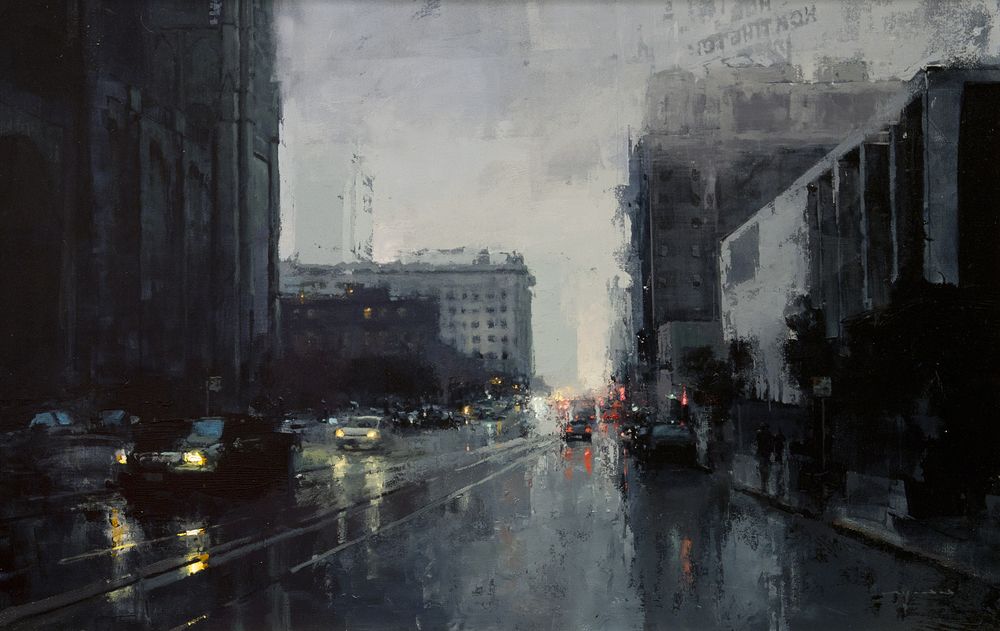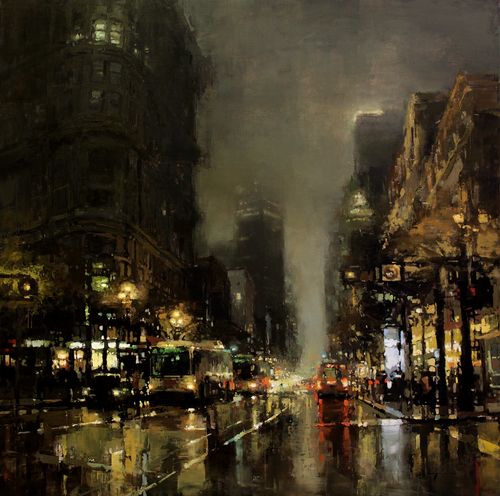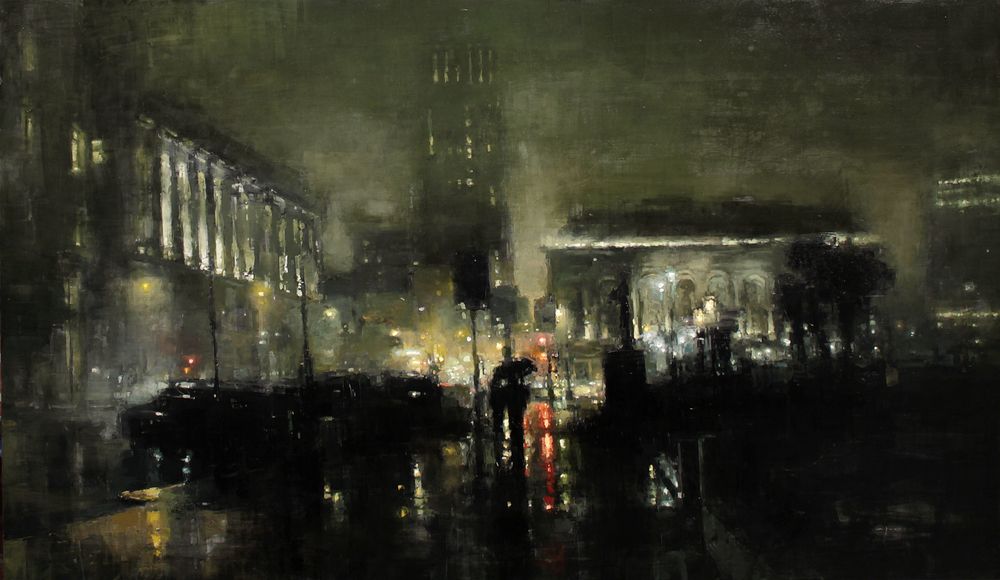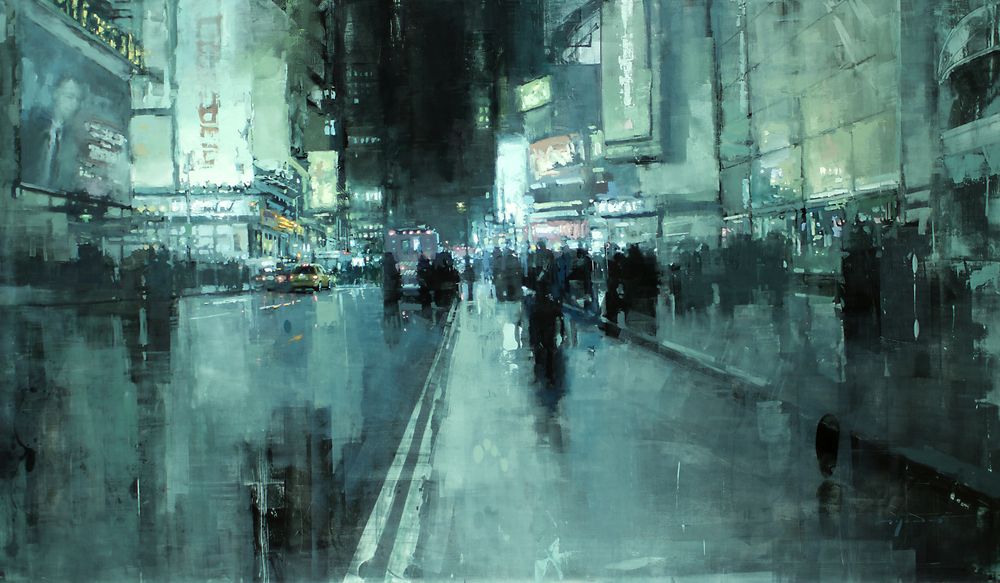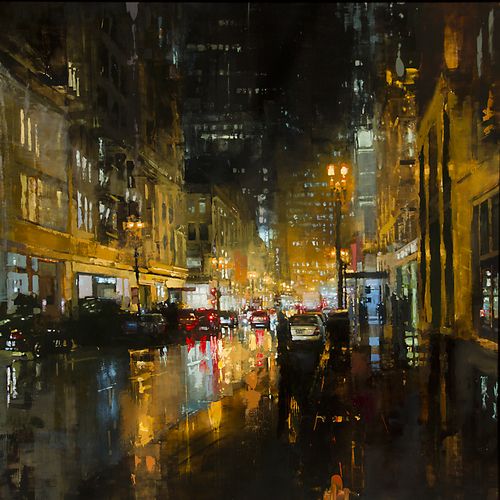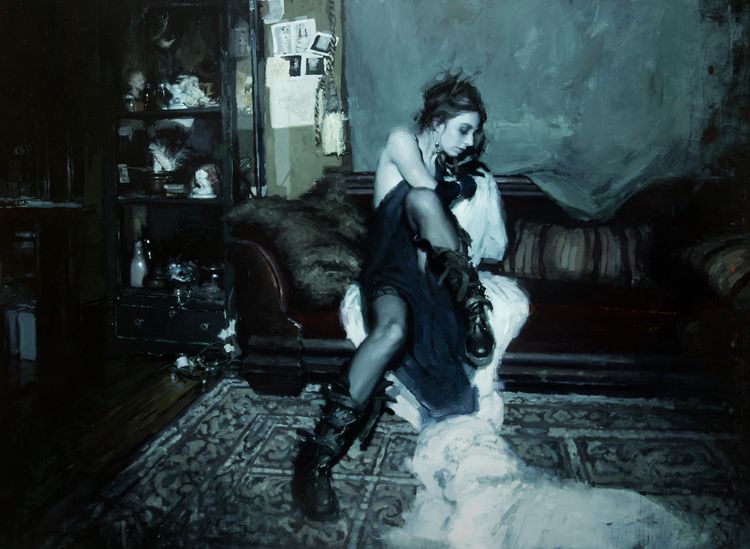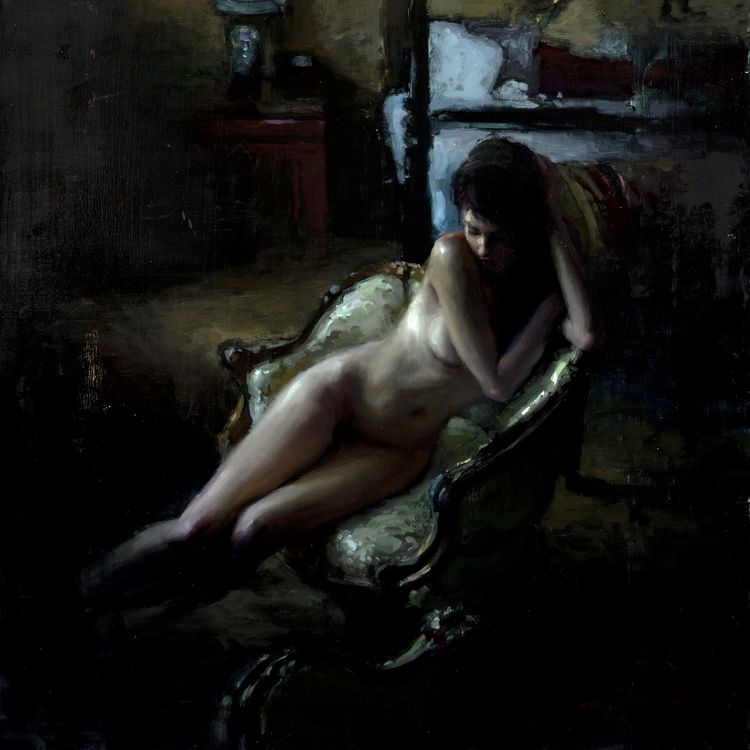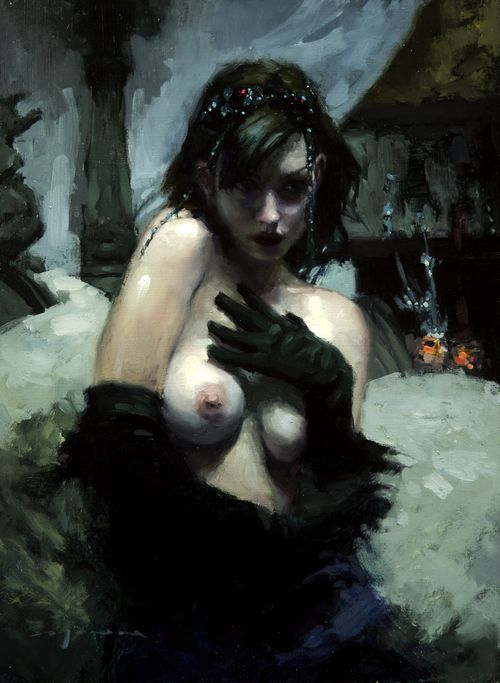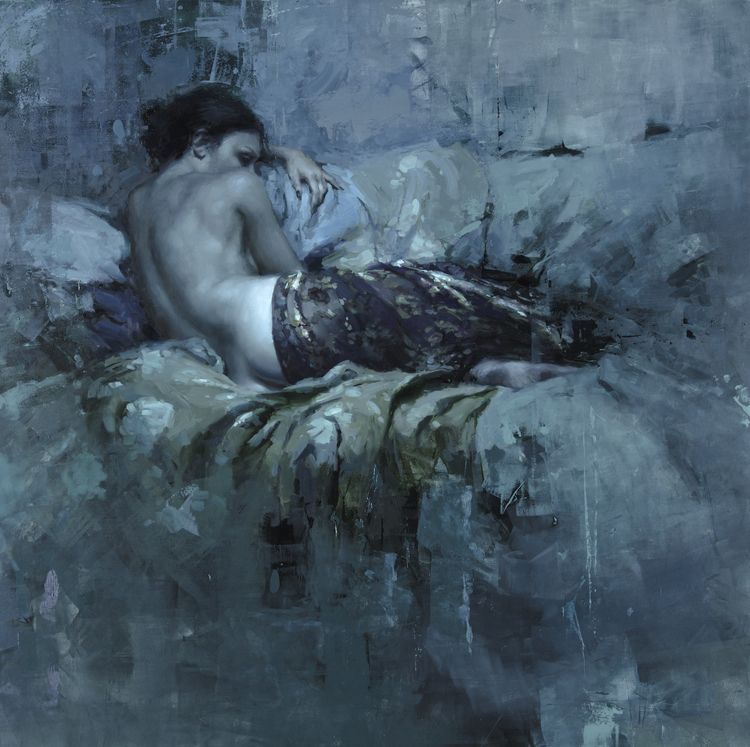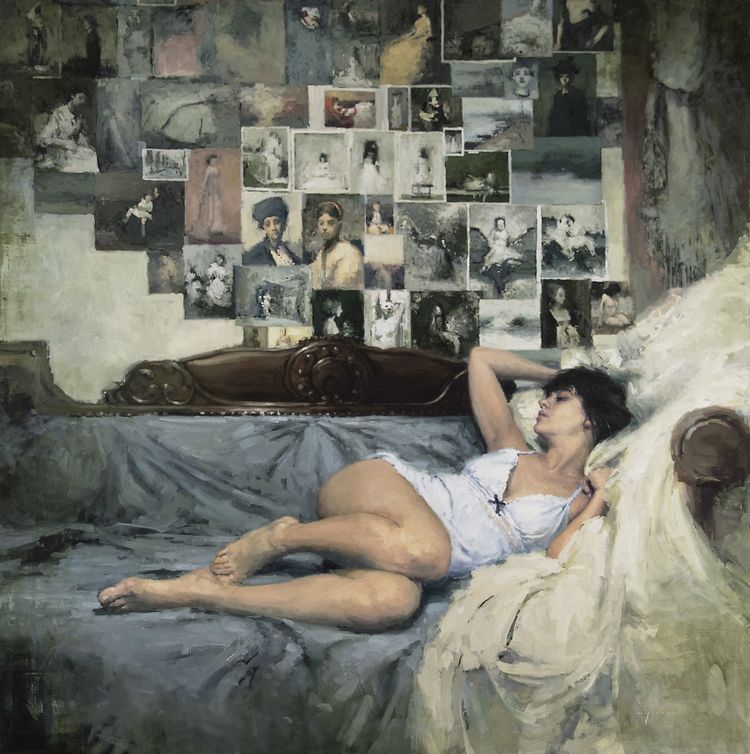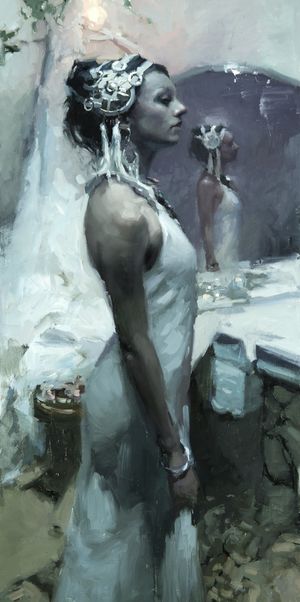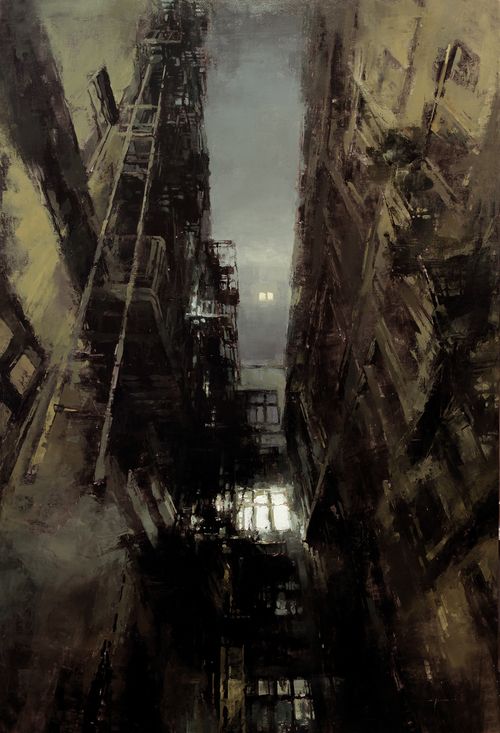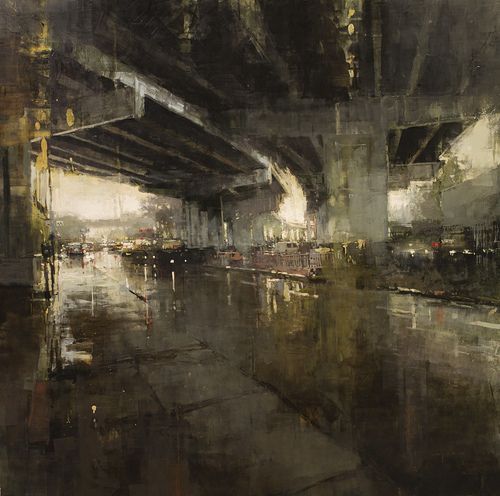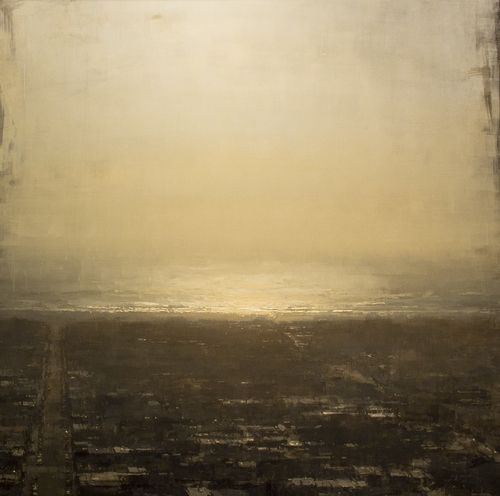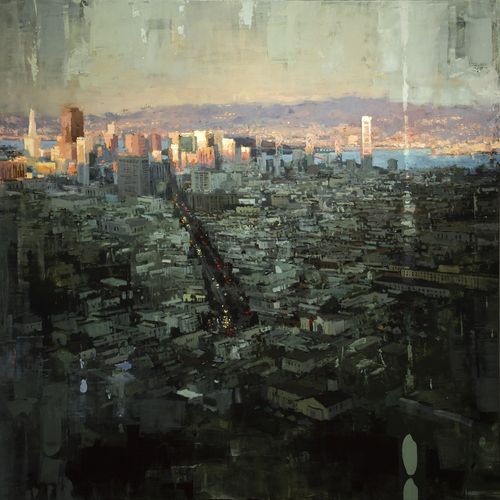Por: Juan Pablo Torres
Crédito de la foto: www.redrabbit7.com
Sueños de urbe, y realidad: Sobre la propuesta de Jeremy Mann
Relación de lugares, viajes, libros… Notas:
Del tiempo y el río, de Thomas Wolfe termina con una escena que claramente se relaciona con la primera de otra gran novela, Llámalo sueño, de Henry Roth. La vuelta en un caso, el primer arribo, en el otro. Tierra firme y atrás la bastedad del océano; otra vida… Pero, de pronto -cosa de luz y rumores- nos encontramos también en una escena -¿toma?- que, digamos, pudo ser «capturada» desde el periscopio de John Dos Passos…
«La tierra de las oportunidades», su complejidad; más allá, luchando, sus criaturas. Un primer asomo…
Una nueva tierra prometida, o lo que es lo mismo: un nuevo camino por soñar… La bastedad es factor importante.
En fin, acaso el escenario no corresponda del todo. Ni siquiera el momento. Pero es que la ciudad, su voz, más allá de la época, ilumina lo mismo. Puede dar otra hora el reloj… En todo caso, llegamos.
Las calles ante nosotros, sin el encanto de La vista del Delft…, pues atrás Europa y aquí, el nuevo camino, ya fue dicho.
Un internamiento. Tampoco queda lejos Pasos, de Jerzy Kozinski…
(Hay múltiples maneras; podríamos también seguir a Saul Bellow, a John Cheever… Al cabo, es nada más una invitación.)
Jeremy Mann, con sus pinturas, logra el aura o, mejor dicho, un aura con aires de universalidad que equipara los escenarios de concreto, fierro, plástico… y hombres, tras el tul del humo que empaña las nubes, y el brillo de la lluvia.
Y claro que nos damos cuenta, al cabo hemos visto tantas veces en tantas películas, estos escenarios… Las postales se hacen solas así… E invitan. Es una tierra en particular, unas iniciales (U.S.A.), y no. Ahora menos que nunca.
Llueve sobre todos. Las luces al cabo son luces y soñamos en cine, por ejemplo, ahora, todos casi por igual, sin importar las coordenadas de nuestra localización.
Mito.
American dream…, pero una vez más, no solo eso. Es Europa también… Su cine… Y el aura que cruzó el Atlántico. Porque conviene recordar, siempre, raíces.
Desde el Petersburgo de Biely a -mil veces- Las calles de Joyce…, lo orgánico, que se remonta, por supuesto, muchísimo más atrás, a la propia gesta… Siempre fundación y aventura, y decadencia, también. Vida.
Y el tiempo…
Queda por ver, entonces, más que la hora: la época…
Cabe preguntarse cuánto han cambiado en realidad las cosas. Y si el cambio, en efecto, desborda la imagen, cuánto aceptamos de ella, y cuánto preferiríamos, quede, por ejemplo, como en la visión de Jeremy…
La distancia, la bruma, el brillo, y la vibración de la propia vida de la urbe impresionan, y como en el caso de Monet…
…, uno se pregunta por los rostros de la gente…
Qué, detrás de las luces…
Y, ya en cuanto a pintura, por ponerlo así, si funcionará al caso la misma técnica, ¿cómo, esta visión, de cerca, en los ojos?
¿En qué modo vive el brillo, detrás de las luces, o bajo ellas, ya no en las calles…, en lo particular…?
Mann entonces nos lleva, no a la experiencia de la ciudad en sus comunes recovecos para lucir el interior de su visión, no a los hogares, si no, para definir del todo su propuesta, al taller.
Bien, si no estaba del todo claro, antes se trataba de paisajes, y por tanto, más que retratos, almas de ciudad; y ahora…
… de figuras. Seres humanos.
Con una elección de por medio, la de un alma de la urbe. Lo que cargue con la misma bruma en la intención, la misma incierta invitación para el destino, el brillo de las posibilidades sensuales: vida bajo la lluvia. Fertilidad.
Deseo.
La sinfonía del aparente caos en las calles, la que, digamos, revela su clave cuando uno levanta la vista y se deja guiar por las luces, la pauta de caminos y, una vez más, el rumor de los destinos de los habitantes de la ciudad, cede paso aquí a melodías preñadas de intensidad por el modo en que las paredes hacen eco del solo… No es solo individualidad…
.., es la provocación del individuo, mas como parte de aquella sinfonía. Un espíritu común en el color. Y la pose y la expresión de los ojos. Caracteres particulares que, sin embargo, alimentan por conjunto, un aura mayor.
Afuera sigue lloviendo. Aquí tampoco hay época…
Drama. Una vez más, deseo. De siempre. Y, por tanto, la luz nos sirve para evocar, nuevamente desde el Cine, o la Literatura…, y ni hablar de la propia Pintura. Noches fértiles de Historia. Potencia…
Tierra de oportunidades, la Tierra entera…
Tradición como entrega. Y resulta curioso: en una época de saltos tremendos, la intensión de eternidad, todavía, con seres humanos protagonizando este conjunto de cuadros.
Y hay atuendos que no solo no pasan de moda. Son casi rituales, sí, tradición… Si bien la pasión es irreductible a esta categoría.
Sin ánimos de ofender por torpe redundancia: es que es más que retrato, y más que un par de ciudades de un solo país. Es una marcha general… Anhelo.
Pero ver, ver…
Al cabo de la noche, o de vuelta al principio de esta, lejos nuevamente, conviene recordar: esas luces encendidas a menudo privan, no siempre otorgan una nueva visión; suele ser necesario hurgar en la sombra, e intuir. Es una pauta.
Un taller es un lugar de previsiones, y no. Como muchos hogares. Las probabilidades son tantas; por ello la importancia de atreverse.
Uno mismo difícilmente alcanza a contener, cuando teme, el primer impulso, asomarse…
El tránsito no se detiene porque uno haya alzado la vista momentáneamente. El eco de un reflejo en la retina no implica necesariamente quietud. Cosa de tiempo.
La vibración impresiona, siempre. Pero es, ojo, una elección.
Es por haber optado por tal modo de tomar el momento que el paisaje, más lejos aún, de vuelta al mar, por ejemplo, no está cargado de los significados de la ya mencionada vista hecha por el Maestro Vermeer… Lo que está más allá no está en lo íntimo, más bien se eleva, y se esfuma. Pretende proyectarse más que profundizar…
Otra forma de rezo.
Lo importante en todo caso, es que al volver la vista abajo, no nos encontremos simplemente con retratos…
Siempre hay más luz. Y deseo.
——————————————————————————————————————————————————–
(versión en inglés)
Traducción: Marion Tejada
City dreams, and reality: About Jeremy Mann’s proposal
Relation of places, trips, books… Notes:
Thomas Wolfe’s Of time and the river, ends with a scene that is clearly related to the first one of another great novel, Call it sleep, of Henry Roth. Return in one case, the first arrival, in the other one. Firm land and behind the coarseness of the ocean; another life… But, suddenly -Thing of light and murmurs- we found ourselves also in a scene -take?- that, let’s say could be «captured» from John Dos Passos’s periscope… “The land of opportunity”, its complexity; beyond, fighting, its creatures. The first look… A new promised land, or, which is the same, a new path to dream about… The coarseness is an important factor.
Well, perhaps the scenario won’t correspond at all. Not even the moment. But it is that the city, its voice, beyond the era, iluminates the same, the clock can give the time… In any case, we arrived. The streets before us, without the enchantments of the view of Delft…, so behind Europe and here, the new path, it was said. An involuntary commitment. Steps, by Jerzy Kosinski isn’t far either… (There are multiple ways; we could also follow Saul Bellow, John Cheever… In the end, it’s nothing more than an invitation.)
Jeremy Mann, with his pantings, achieves the aura or, rather, an aura with alleged universality that equates the concrete scenarios, iron, plastic… and men, behind the tulle of smoke that mists up the clouds, and the brilliance of rain.
And of course what we don’t realise, in the end we’ve seen so many movies, this scenarios… The postcards are made on its own… and invite us. It’s a particular land, initials (U.S.A), and not. Now less than ever.
It rains on all of us. The lights in the end are ligths and we dream in movie mode, for example, now, almost everyone, no matter the coordinates of our location.
Myth.
American dream…, but once again, it’s not only that. It’s Europe too… its films… and the aura that crossed the Atlantic. Because it should be remembered, always, roots.
From Biely’s Petersburg to -a thousand times- Joyce’s streets…, the organic, what rises up, of course, far behind, to the songs of heroic deeds itself… Always foundation and adventure, and decandence, too. Life.
And time…
It remains to be seen, then, more than time: the era…
One wonders how much have things really changed. And if change, in fact, overflows the picture, how much do we accept of it, and how much would we prefer, to stay, for example, like in Jeremy’s vision…
The distance, the haze, the glow, and the vibration of the city’s own life impresses, and like in the case of Monet…
…, and one wonders aout the faces of people…
What, behind the lights… And, as far as painting, so to speak, will the same technique work, how, this vision, close, in the eyes?
In which way does the glow live, behind the lights, or underneath them, not longer in the streets…, on the particular…?
Mann then takes us, not to the experience of the city in its common nooks to show the interior of his vision, not to the homes, if not, to define entirely his proposal, to the workshop.
Well, if it wasn’t very clear, before it was about landscapes, and therefore, more than portraits, souls of the city; and now…
…of figures. Human beings.
With an election in between, a city’s soul. Whatever it takes with the same haze in the intention, the same uncertain invitation to destiny, the glow of sensual possibilities: life under the rain. Fertility. Desire.
The symphony of the apparent chaos in the streets, which, let’s say, reveals its key when one looks up and is guided by the lights, the pattern of roads and, once more, the murmur of the fate of the inhabitants of the city, gives way to melodies pregnant with intensity because of the way in which the walls make an echo of the solo… It’s not only individuality…
.., it’s the individual’s provocation, more like a part of that symphony. A common spirit in colour. And the pose and the expression in the eyes. Particular characters that, however, are fed by a bigger aura.
Outside is still raining. Here there’s no era either…
Drama. Once more, desire. Always. And, therefore, the lights works for us to evoke, again from the movies, or Literature…, and not to mention the very own Panting. Fertile nights of History. Potence…
Land of opportunity, the Earth, all of it…
Tradition as dedication. And results curious; in an era of huge jumps, the intention of eternity, still, with humans starring this set of pictures.
And there are outfits that not only are not outdated. They are almost rituals, yes, tradition… Althought passion is irreducible to this category.
No offense by clumsy redundancy: It’s more than a portrait, and more than a pair of cities of just one country. It’s a general course… Yearning.
But to see, see…
At the end of the night, or back to the beginning of it, far again, it should be remembered: those lights on often deprive, not always give a new vision; it’s usually required to rummage in the shadow, and intuit. It’s a standard.
A workshop is a place of precaution, and not. Like many homes. The odds are so many; that’s why the importance of daring.
One self hardly reaches to contain , when fears, the first impulse, leaning out…
Traffic doesn’t stop because one has looked up momentarily. The echo of a reflection in the retina doesn’t imply necessarily stillness. A matter of time.
The vibration impresses, always. But it is, watch out, a choice.
It’s for having chosen the way of taking the moment in which the landscape, even further, back to the sea, for example, not being filled of the meanings of the already mentioned view made by the Master Vermeer… What’s beyond is not in the intimate, rather it rises, and vanishes. It aims to project more than to deepen… Another form of prayer.
In any case, the important is that when we look back down, we don’t find ourselves with simply portraits…
There’s always more light, And desire.





